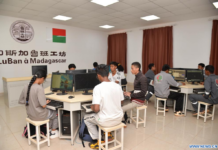Addressing Gender Gaps In Cameroon To Enhance Inclusive Growth – By Ayuk Takemeyang Aka
As women in Cameroon are preparing once more to join other women all over the world to celebrate the International Women’s Day on the 8th of March 2024.
There is need to remind the “power that be” that addressing gender gaps in Cameroon to enhance inclusive growth is a topic of contemporary significance and relevance. The International Women’s Day celebration 2024 will focus on the theme, ‘Count Her In: Accelerating Gender Equality through Economic Empowerment’.
The theme aligns with the priority theme for the United Nation 68th Commission on the Status of Women (CSW 68) and will examine pathways to greater economic inclusion for women and girls everywhere. The theme recognizes that, despite progress, women face significant obstacle to achieve equal participation in the economy and calls for ensuring equal opportunity for women and girls to build their capabilities and strengthen their capacity to learn, earn and lead.Gender inequality remain a serious problem in Cameroon.
Going by the 2035 Vision of Emerging Cameroon,the promotion of gender equality in Cameroon is a key factor for the achievementof inclusive growth and meeting the Sustainable Development Goals (SDGs). Gender gaps prevent women from fully participating in the economy.Women suffer more from poverty and unemployment and tend to work in low paying activities. Women’s access to education, finance and health is lower than for men. According toa report about Cameroon that was prepared by a staff team of the International Monetary Fund, Almost 40 percent of women are married before age 18, resulting in fertility and maternal mortality rates well above the Sub Saharan Africa average.
Cameroon was ranked 118 out of 134 countries in 2009 in the World Economic Forum Gender Gap Index and 141 among the 189 countries ranked in relation to their level of gender inequality (UNDP, 2017). The Gender Index Gap report examine countries on how effective they distribute their resources and opportunities among their male and female populations, irrespective of the overall levels of these resources and opportunities.The Cameroon government is presently doing quite a-lot to address this gender gaps.Gender inequality indicators are improving but progress is still needed in term of women’s access to assets and political empowerment. There is need to ensure improve legal and institutional system mainly regarding non-land assets ownership and violence against women as well as ensuring that existing statutory laws are applied.
The government authorities’ in charge of the 2015 National Gender Policy Paper (NGP) aims at providing an environment that protects women, provides equal access to social services and equal right and opportunities. Relying on Sustainable Development Goal no 5 on gender equality and empowerment of women and girls, the NGP relies on 4 pillars: (i) creating a conducive environment for social protection and equitable access to social services, (ii) ensuring equal rights and opportunities in resources control, (iii) creating conditions for equal participation to development actions, and (iv) ensuring institutionalization of gender in public/private affairs.
The Cameroon government so far in reducing the gender gap has been able to intensify the fight against genderdiscrimination and sexual harassment. In the education system, specific trades such as a Master’s Degree in Gender and Development have been introduced at universities. Free primary schooling has contributed to increasing girl-to-boy enrollment ratios. Collective weddings organized by the authorities in charge of women empowerment contribute to reduce women’s vulnerabilities amid unrecognized cohabitation by the law.
However,there have been noticeable improvements in women’s economic empowerment but more still need to be done in the following areas:reducing gender gaps in terms of access to formal work and equal earnings.The Cameroonian girl, mother, women or wife is domestically employed and responsible for the household.Political empowerment needs to be sustained especially in senior public positions.
The 2010,IMF employment survey shows that 9 out of 10 women are employed in the informal sector and larger share of men are employed in the public and formal private sectors.There are only 17 percent of women in cabinet positions, and no women among regional governors. Women represent a ¼ of legal professionals (judges, bailiffs, notaries, and lawyers).Progress in the health sector has been slow, especially for women.
The HIV prevalence rate for women, 5.6 percent in 2016, is almost twice that of men. In addition, the fertility rate remains high, 4.7 children per women, as a result of high unmet family planning (24 percent of married women) and limited use of modern contraception, mainly in rural areas. Violence against women is pervasive with 51 percent of women reporting to have experienced physical or sexual violence in their lifetime.
In terms of education,Cameroon’s education gender gap is larger in primary and secondary education while it is narrower in the tertiary education suggesting a relatively better retention rate for women at upper school levels. Barriers to female access to education include poverty, juvenile pregnancies, and early marriage with 13.4 percent of girls married before age 15 and 38.4 percent before age 18.The female male ratio in primary school enrollment is also less than 80 percent in the Northern Regions.Women are underrepresented in the field of science and technology with less than 21% of women from 2003-2007 taking up the science subjects.despite policies employed by the state and other educational stakeholders aimed at bridging the educational gender gap, the gap still exist as Cameroon was ranked 126 out of 135 countries in the global gender educational attainment in 2012 giving a score of 0.629 which signifies inequality.
Also,access to finance is generally low among the women in Cameroon.Female account ownership is 10.2 percent compared with 26.2 percent for Sub Sahara African countries.Cameroun has ratified several international treaties that promote gender equality and prohibit violence against women, but progress in transposing their dispositions into national law has been slow. The country’s labor code and the general statute of the civil service prohibit any form of discrimination including on gender. However, the 2017 criminal code and the 1981 civil code continue to include discriminatory provisions against women and do not fully protect women against domestic violence.
The legal marriage age is 15 for women compared to18 for men. According to the 2018 Women, Business and the Law, there are still regulations that restrict women’s employment and legally preventing them, without a permission, from getting a job and applying for a passport and a national identity card. Women can perform an economic activity and own property; however, the husband can prevent the wife from working for the household’s interest, and he has the right to administer, sell or mortgage shared marital properties without the wife’s consent.Some employers and professions requires a husband permission before their spouses are hired.
In addition, customs and traditions weigh heavily against implementing and improving the law.In rural areas, customary laws are often used to settle domestic and property disputes which often tend to deprive women from their rights. In the case of inheritance, most cultures in Cameroon tend to provide a larger share to men, despite the legal provisions that grant equal right to women and men. In addition, the prevalence of gender based violence is high (51 percent of surveyed women) often unreported because it remains widely and socially accepted. Also,polygamy remains the default matrimonial regime, which adversely differentiate women against men.
Recommendations
Cameroon has made rapid and significant progress in reducing gender inequality in recent years, and stands to gain from further reducing remaining gender gaps, if the following recommendations are implemented:
- Pursuing ongoing efforts to translate approved international treaties that promote gender equality into domestic laws and issue implementation decrees to operationalize existing laws. Widespread implementation of the new penal code will ensure better protection of women against violence and harassment.
- Moving to more gender responsive budgets while increasing budgetary resources and allocations to the education and health sectors.
- Encouraging women’s entrepreneurship, financial inclusion and access to formal work, and eliminating remaining legal barriers to women’s access to property and enhancing women’s education.
- Continuing to support increased women’s political participation.
Conclusion
Reducing gender gaps in Cameroon could enhance women’s access to finance, increase entrepreneurial activities and, in turn, reduce income inequality and help Cameroon to become an emerging economy by the year 2035. No meaningful growth and development can take place in Cameroon without addressing the gender gaps.
By Ayuk Takemeyang Aka
The Internationalist holds a Master’s degree in Banking and International Finance from the International Relations Institute of Cameroon, IRIC (University of Yaounde II) and is a Ph.D Fellow.



























![Le chocolatier suisse Läderach développe une histoire d’amour avec la Chine [ INTERVIEW ]](https://www.afrique-54.com/wp-content/uploads/2023/12/Johannes-Laderach-et-chocolat-e1702548585357-218x150.jpg)












